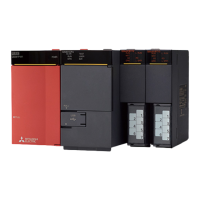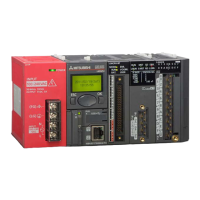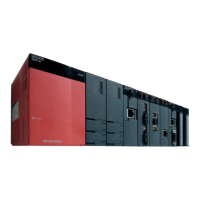8
CPU MODULE START-UP PROCEDURES
8.1 Procedure before Operating in SAFETY MODE
8 - 2
1
OVERVIEW
2
SYSTEM
CONFIGURATION
3
GENERAL
SPECIFICATIONS
4
CPU MODULE
5
POWER SUPPLY
MODULE
6
BASE UNIT
7
BATTERY
8
CPU MODULE START-
UP PROCEDURES
(To the next page)
(Continued from the previous page)
Connecting a personal computer in which GX Developer is installed
1) Start up GX Developer on the personal computer in which GX Developer is installed.
2) Connect the personal computer with GX Developer installed, to the CPU module.
Registering the CPU access password with the CPU module
Register the CPU access password with the CPU module by using GX Developer.
Setting clock data and clearing history data of the CPU module
When the safety CPU module is operated for the first time after purchase, take the following
actions for the CPU module with GX Developer.
Set the clock with "Clock setup".
Clear the error history of the CPU module with "PLC diagnostics".
Writing the parameters and programs to the CPU module
Write the parameters and user programs created by GX Developer to the CPU module.
Restarting the system
Turn off and then turn on the system power supply, or reset the CPU module.
Running the CPU module
Set the RUN/STOP/RESET switch of the CPU module to the RUN position.
Confirm that the "ALIVE" LED, "RUN" LED, and "TEST" LED of the CPU module are on.
Checking the user program operation
Check the user program operation, cables, and inputs/outputs.
When the "ERR." LED of the CPU module is on or flashing, identify the error cause by the
diagnostics*
2
of GX Developer to eliminate the error cause.
When the error is related to the parameters or programs, correct them.
*2: The following types of diagnostics are available.
PLC diagnostics
CC IE Control diagnostics
CC-Link / CC-Link/LT diagnostics
System monitor
Initializing the PLC memory of the CPU module
Initialize the PLC memory of the CPU module with GX Developer.
Confirming the CPU module LEDs
Confirm that the "ALIVE" LED and "TEST" LED of the CPU module are on.
(Confirm that the CPU module is in TEST MODE.)
1
Installing a battery
Install a battery to the CPU module.
Powering ON the power supply module
Confirm the following items of the safety PLC system, and then turn on the power supply.
Wiring of the power supply
Power supply voltage
Operating status of the CPU module Stop status (The RUN/STOP/RESET switch is
in the STOP position.)
Ethernet diagnostics
MELSECNET diagnostics
• • • CHAPTER 4
• • • GX Developer Version 8
Operating Manual
• • • GX Developer Version 8
Operating Manual
(Safety PLC)
• • • GX Developer Version 8
Operating Manual
(Safety PLC)
• • • GX Developer Version 8
Operating Manual
GX Developer Version 8
Operating Manual
(Safety PLC)
• • • GX Developer Version 8
Operating Manual
• • • CHAPTER 4
• • • CHAPTER 4
• • • CHAPTER 4
• • • CHAPTER 7
• • • CHAPTER 4,
CHAPTER 5,
CHAPTER 10

